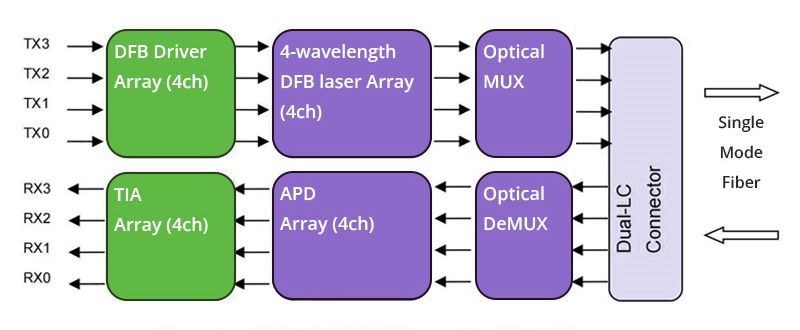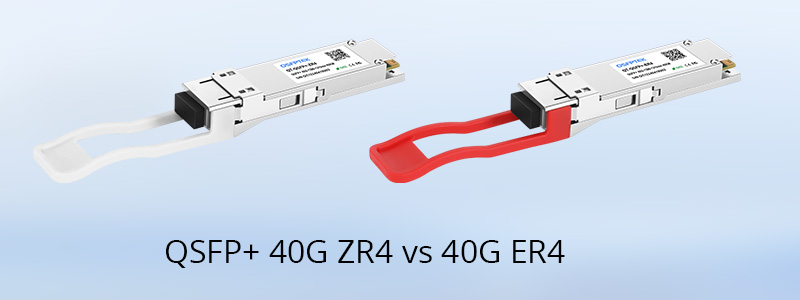What is QSFP+ 40G ER4 Optical Transceiver?
As a high-performance optical communication device, the QSFP+ 40G ER4 optical transceiver has become popular in 40G Ethernet deployment due to its excellent transmission distance, compatibility, and integration. This article will comprehensively introduce the working principle, advantages, and application scenarios of the 40G ER4 QSFP+ optical module, and compare it with the 40G ZR4 module to help you more clearly understand how to choose the appropriate optical module solution according to actual needs.
40G ER4 QSFP+ Transceivers Overview
What is 40GbE QSFP+?
QSFP+ is short for Quad Small Form-factor Pluggable Plus, an optical module form factor widely used in high-speed data communications. Compared to earlier SFP+ transceivers, QSFP+ transceivers integrate four data channels to support higher data rates and port densities.
When a QSFP+ module is used for 40G Ethernet (40GbE), it is often referred to as a 40G QSFP+ optical module. It transmits data at a total rate of 40Gbps over four parallel channels at 10Gbps each.
What is ER4 40G QSFP+ Module?
40G ER4 QSFP+ transceiver module is equipped with LC duplex connectors, reaching a link up to 10km over OS2 single-mode fiber (SMF). This 40G ER4 optical transceiver comes with a bidirectional 4-channel QSFP+ connector, enabling a total of 40 Gbps bandwidth by each channel carrying a 10 Gbps data rate. The 40GBASE-ER4 QSFP+ module is compliant with QSFP+ MSA and IEEE 802.3ba 40GBASE-ER4 specifications.
Benefits of 40GBase-ER4 QSFP+ Modules
Long Distance Transmission Capability
40GBase-ER4 modules typically have a maximum transmission distance of up to 40km, making them suitable for Metropolitan Area Networks (MANs) or long-distance backbone networks. This distance is much longer than modules such as SR4 (150m) and LR4 (10km).
High integration and small form factor
The QSFP+ form factor has the characteristics of a small size, which is convenient for high-density deployment in equipment. QSFP+ saves space and is very suitable for environments with high space requirements in data centers and network rooms.
Strong compatibility and flexible deployment
Most QSFP+ 40G ER4 modules comply with the IEEE 802.3ba standard and QSFP MSA specification, and are compatible with mainstream switches, routers, and optical fiber equipment, facilitating network expansion and upgrades.
How Does QSFP 40G ER4 Single-mode Transceiver Work?
At the transmitting end, the module converts four 10Gbps electrical signals into four CWDM optical signals at wavelengths of 1271nm, 1291nm, 1311nm, and 1331nm, then multiplexes them into one optical signal over a single fiber for transmission.
At the receiving end, the module uses a demultiplexer to separate the received composite optical signal into four individual CWDM channels, and then converts each optical signal into an electrical signal, outputting four channels of electrical data.
Applications of 40G QSFP+ ER4 Optical Modules
With the rapid development of cloud computing, big data, AI, and other technologies, the demand for high-speed, high-density, high-reliability network communications is rising. In this market context, 40G QSFP+ ER4 optical modules, as an advanced transmission technology, will be widely used in data centers, communication network construction, optical communications, and other fields. 40G QSFP+ ER4 optical modules are suitable for a variety of application scenarios. The following are some typical scenarios:
Data Centers
The 40G QSFP+ ER4 module supports single-mode fiber transmission up to 40km and is suitable for cross-campus data center interconnections as well as high-speed connectivity between data center core switches. Compared to traditional multimode modules, the ER4 enables high-speed communication over long distances without relying on trunking equipment, increasing the flexibility and scalability of the network architecture.
Metropolitan Area Networks (MANs)
In metropolitan area networks, large amounts of data often need to be transmitted between different office buildings, campuses, and operator nodes over distances of 10 to 40 kilometers. The 40G QSFP+ ER4 optical module can be used to increase network transmission rates and expand network capacity.
4G Communications
40G QSFP+ ER4 optical modules are mainly used in 4G communication networks, particularly for long-distance transmission. They provide stable and high-speed connections to support the bandwidth demands of 4G base stations.
QSFP+ 40G ZR4 vs 40G ER4, What's the Difference?
What is 40GBASE-ZR4 QSFP+ Module?
40G ZR4 QSFP+ optical transceiver is equipped with LC duplex connectors, reaching a link up to 80km over OS2. 40GBASE-ZR4 QSFP+ transceiver module is compliant with QSFP+ MSA and IEEE 802.3ba 40GBASE-ZR4.
The 40G QSFP+ ZR4 module uses WDM technology, where a MUX/DEMUX merges multiple wavelength signals into one optical fiber for transmission.
40G QSFP+ ZR4 module converts four 10G data input channels into four WDM optical signal channels, each supporting a data transmission rate of up to 11.2Gbps.
QSFP 40G ER4 vs 40G ZR4: Key Differences and How to Choose
To clearly illustrate the differences between the 40G QSFP+ ZR4 and QSFP+ ER4 transceivers, the following comparison is based on two 40G optical modules from QSFPTEK.
When choosing between QSFP+ 40G ER4 and ZR4 optical modules, the key lies in the transmission distance you need. If your link length is within 40 kilometers, ER4 is usually sufficient, which can reduce costs and power consumption while meeting performance requirements. When the transmission distance exceeds this range, or the network environment is more complex and requires more stability and receiving performance, ZR4 is a more reliable choice. In short, judging by distance and network performance requirements can help you choose the right module more efficiently.

Conclusion
The QSFP+ 40G ER4 optical transceiver is a good solution for 40G Ethernet since it supports long-haul transmission, small size, and wide compatibility. Playing prominently in data centers, metropolitan area networks, and 5G communication infrastructures, it delivers fast and reliable connections over single-mode fiber up to 40 km. Compared to QSFP+ 40G ER4 vs 40G ZR4, the 40G QSFP+ ER4 module provides lower power consumption and cost. Choose 40G ER4 QSFP+ transceiver modules for typical long-range needs, and opt for 40G QSFP+ ZR4 modules when your network requires up to 80km reach or higher performance.











